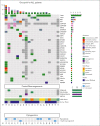Lenalidomide-associated B-cell ALL: clinical and pathologic correlates and sensitivity to lenalidomide withdrawal
- PMID: 36827680
- PMCID: PMC10362546
- DOI: 10.1182/bloodadvances.2022009212
Lenalidomide-associated B-cell ALL: clinical and pathologic correlates and sensitivity to lenalidomide withdrawal
Abstract
Lenalidomide is an effective component of induction and maintenance therapy for multiple myeloma, though with a risk of secondary malignancies, including acute lymphoblastic leukemia (ALL). In contrast to therapy-related myeloid neoplasia, lenalidomide-associated lymphoblastic neoplasia remains poorly characterized. We conducted a dual institution retrospective study of 32 ALL cases that arose after lenalidomide maintenance (all B-lineage, 31/32 BCR::ABL-negative). B-cell ALL (B-ALL) was diagnosed at median 54 months (range, 5-119) after first exposure to lenalidomide and after median 42 months of cumulative lenalidomide exposure (range, 2-114). High incidence of TP53 mutations (9/19 evaluable cases) and low hypodiploidy (8/26 patients) were identified. Despite median age of 65 years and poor-risk B-ALL features observed in the cohort, rates of complete response (CR) or CR with incomplete hematologic recovery were high (25/28 patients receiving treatment). Median event-free survival was 35.4 months among treated patients (not reached among those undergoing allogeneic hematopoietic cell transplantation [HCT]). Sixteen patients remain alive without evidence of B-ALL after HCT or extended maintenance therapy. We also describe regression of B-ALL or immature B-cell populations with B-ALL immunophenotype after lenalidomide discontinuation in 5 patients, suggesting lenalidomide may drive leukemic progression even after initiation of lymphoblastic neoplasia and that lenalidomide withdrawal alone may be an appropriate first-line intervention in selected patients. Monitoring for early B-ALL-like proliferations may offer opportunities for lenalidomide withdrawal to prevent progression. Established combination chemotherapy regimens, newer surface antigen-targeted approaches, and allogeneic HCT are effective in many patients with lenalidomide-associated B-ALL and should be offered to medically fit patients.
© 2023 by The American Society of Hematology. Licensed under Creative Commons Attribution-NonCommercial-NoDerivatives 4.0 International (CC BY-NC-ND 4.0), permitting only noncommercial, nonderivative use with attribution. All other rights reserved.
Conflict of interest statement
Conflict-of-interest disclosure: M.B.G. received research support from Actinium Pharmaceuticals and Amgen; is on the advisory board of and received research support from Sanofi; and is a consultant for Allogene and Novartis. W.X. received research support from Stemline Therapeutics. The remaining authors declare no competing financial interests.
Figures





References
-
- Palumbo A, Bringhen S, Kumar SK, et al. Second primary malignancies with lenalidomide therapy for newly diagnosed myeloma: a meta-analysis of individual patient data. Lancet Oncol. 2014;15(3):333–342. - PubMed
Publication types
MeSH terms
Substances
Grants and funding
LinkOut - more resources
Full Text Sources
Medical
Research Materials
Miscellaneous

